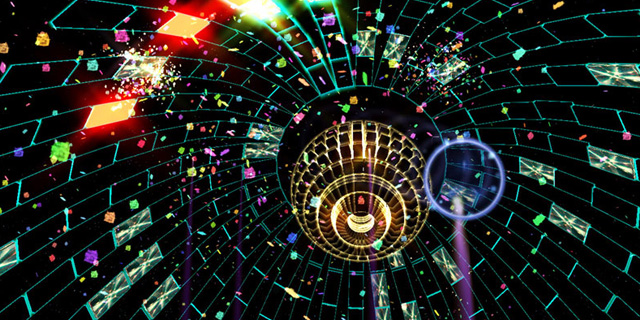
Child of Eden is an experience. Yes, on a base level it’s a game, but it’s not the mechanics or progression that you’re really getting into this for. It’s visceral, it’s immersive, and it’s… maybe not everyone’s cup of tea.
Conceived as a Kinect title, Child of Eden is Tetsuya Mizuguchi’s spiritual successor to Rez. The story is incomprehensible, but we’ll try to explain it. So, the Internet. Right? Internet? Okay, for some reason, people decide to start calling it Eden. Then there’s this girl, Lumi, recreated virtually in it. And she’s being attacked by a virus. So you’re saving her. All this doesn’t matter, though, as it’s about emotional reactions to the Genki Rockets-fueled audiovisual stimuli.
All this wraps around an on-rails shooter, with colorful polygonal objects coming at you from all directions. You have two main weapons: the Lock-On Laser lets you swipe across a group and fire at them all, and the Tracer is a rapid-fire weak shot you send out with your trigger. Mostly, you’ll stick to locking on, but some enemies are weaker to individual shots, and you’ll have to manage the two.
The mechanics are based on Kinect controls, so they’re designed for a lot of swiping. This translates well to Move controls on the PS3, as it was based on hand movement anyway. You can still wave your arm to swipe across enemies, and though you don’t get that magical feeling controller-free gaming brings, you’ll be very happy you have buttons to trigger things after a few minutes. (You can play with a regular controller, but come on. That’s not magical at all.) There’s also 3D support, if you have the equipment to use it.
The shooting can be a bit difficult at times if it’s not your thing. Knowing some people would just want to experience it anyway, Q Entertainment made sure to include a no-fail mode. Of course, if you’re into rail shooters, there are leaderboards and a hard mode.
You’ll be done with the main Child of Eden experience in a few short hours. It’s an entertaining evening, and that may not be worth a full purchase for everyone. Here’s the thing: it’s not something you get the chance to play very often. (By our count, we’re getting one about once a decade at this point.) You may just need to pony up the premium for the opportunity.
Pros: Immersive audiovisual experience
Cons: A bit short, not much gameplay



















